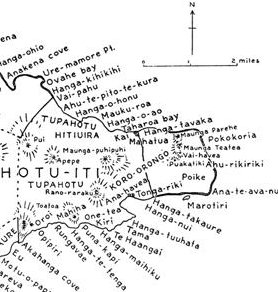|
Pare Half raw, badly cooked.
Parehaoga, food prepared in the earth oven (umu
parehaoga) for a feast or for people whose help is
needed for some work or for organizing a feast.
Parehe,
piece, bit; to fall, break into pieces. Parei, dirty,
to have a dirty face and eyes, someone who gets up without
washing. Parera, sea bottom.
Ta.: Pare, a fort, a place of
refuge. Ma.: parepare, a breastwork in a stockade.
Mgv.: Pare, a covering for the head. Mq.: pae,
id. Sa.: pale, id. Ma.: pare, id.
Parehe, to break, a crack.
Parei,
1. (paré), dressed up. 2. To sparkle (of the eyes).
Parera, 1. A shallow, a reef. 2. Deep water, profound,
gulf; parera tai, deep sea; tai parera, high
tide; hohonu parera, fathomless, unsoundable. 3. To
lead astray. Hakaparera, to frighten, to scare.
Pareu, skirt, apron. Mgv., Mq., Ta.: pareu,
loincloth, apron. Pau.: Parego, to drown oneself.
Ta.: paremo, drowned. Ma.: paremo, id.
|
